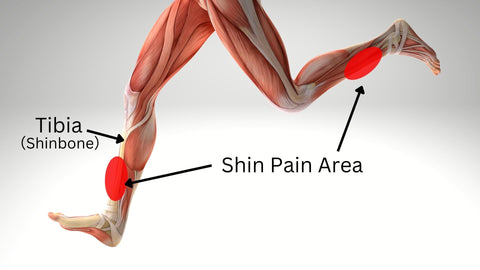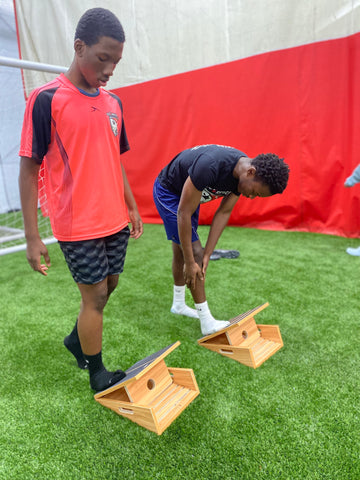
Do you have pain in your shins after running? Are you having a hard time keeping up with your new workout routine because of the pain in your shins? You are not alone. Shin splints are a very common injury, and more than 3 million people get them each year in the United States.
In this article, you will learn what Shin Splints are and how to prevent them from happening in the future.
What are Shin Splints?
Shin Splints is a term that refers to the pain in front of your lower leg, and at times can also be felt along the inside of the leg, directly next to your shin bone (tibia). This condition can happen when your muscles and tendons around the shin get overworked.

The possibility of developing shin splints increases when you do a lot of exercise or play strenuous sports, such as tennis, racquetball, soccer, or basketball. Athletes are more likely to get shin splints, but anyone who does activities that place pressure on their shins can get them as well.
Shin splints can be painful and debilitating, making it difficult to walk or even stand. This can be a major setback for those who are active. However, there are steps you can take to prevent shin splints from occurring or becoming worse. With proper care and prevention, you can keep shin splints from impacting your life.
What Causes Shin Splints?
Shin splints are a type of injury that is often caused by overuse or repetitive impact on the lower leg. This can happen when you run or play tennis, for example. When this impact happens over and over again, it can cause the muscles and tissues around your shin to become inflamed and painful.
In some cases, shin splints can also be caused by overpronation. This is when the foot rolls inward too much when walking or running, which can put extra stress on the shinbone and the muscles and tissues around it.
Shin splints can also be caused by having flat feet. When you walk, the shock from your foot hitting the ground travels up your leg to your shinbone. This can cause inflammation and tiny tears in the tissue that surrounds the bone.

Who is at risk for shin splints?
You're more at risk of shin splints if:
- You're a runner, especially if you're just starting out.
- Your sport involves fast stops and starts (such as soccer or downhill skiing)
- Your exercise routine suddenly becomes longer, more frequent, or more intense
- You run on uneven terrain, like hills, or on hard surfaces, like concrete
- You are using worn-out or inappropriate shoes for working out or running
- You're in military training
- You have flat feet or high arches
You are more likely to get shin splints when your leg muscles and tendons are tired. Shin splints can affect women, people with flat feet, people with rigid arches, athletes, military recruits, and dancers.
Shin Splints Symptoms
There are a number of symptoms associated with shin splints, including:
- a dull ache in the front part of the lower leg
- pain that develops during exercise
- pain on either side of the shin bone
- muscle pain
- pain along the inner part of the lower leg
- tenderness or soreness along the inner part of the lower leg
- swelling in the lower leg (usually mild, if present)
- numbness and weakness in the feet
The following symptoms may indicate you need medical attention if your shin splints do not respond to common treatment options:
- severe pain in your shin after a fall or accident
- a shin that feels hot
- a shin that’s visibly swollen
- pain in your shins even when you’re resting

5 Top Tips to Help You Heal and Prevent Shin Splints
Shin splints are often treated effectively and can be prevented if they're treated early on. Here are some simple steps that you can take on your own to help you heal and prevent shin splints from developing.
Shin Splints Treatment
If you’re experiencing shin splints, there’s many things you can do to help them go away. Here are some ways to get rid of shin splints.
- Elevate your legs with a footrest.
- For swelling relief, apply ice packs.
- Take an over-the-counter pain reliever like ibuprofen (Advil) or naproxen sodium (Aleve).
- Wear elastic compression bandages.
- Massage your shins with a roller.
Prevention tips for Shin Splints
Shin splints can be a frustrating experience, but with the right treatment and prevention plan, you can get back to your running routine quickly. Here are five tips to help prevent shin splints.
1. Stretch your calves and hamstrings
Having tight muscles in your leg can put you at risk of developing shin splints. If you're experiencing tightness in your leg muscles, it's critical to stretch and warm up before exercising. Stretch your calves and hamstrings with an adjustable slant board.

2. Strengthen your foot and the arch of your foot
The arch in your foot is formed by the time you are 7 to 8 years old. Other things, like injury and age, can change the shape of your arch. If you don't do any physical activity, the muscles in your foot, lower leg, thigh, and trunk will get weak. This can lead to shin splints.
One way to start strengthening your foot is by using your toes to pull a towel closer to you while you are sitting down. This can help the arch muscles in your foot and may reduce or prevent shin splint pain. See a physical therapist for more exercises that will work best for you.
3. Strengthen your hip muscles
By exercising your hip muscles, you can help to absorb more of the shock and pressure that is placed on your joints. This, in turn, can lead to less pain and irritation in the hips and joints, and can overall improve your mobility and quality of life.
4. Make sure you use the right athletic shoes
If your shoes do not fit correctly or if they are missing important features, this can lead to shin splints. Speak with your physical therapist about the right shoe features for you. Depending on your activity, you may need to replace shoes often. It’s a good idea to have several pairs of good athletic shoes, and switch between them regularly.
5. Improve your running and jumping technique
Incorrect running, jumping, and landing techniques can cause shin splints. This is because when you land incorrectly, your shinbone and muscles around it absorb the brunt of the impact. Proper technique is crucial for preventing this painful condition. If you're not sure what the correct techniques are, consult a coach or certified trainers.
What is a Slant Board?
A slant board is a flat-surfaced device that is made from durable wood or lightweight plastic material and is used to keep muscles and tendons in tip-top shape.
By standing in a slanted position on this board, you improve the performance of your muscles for exercise and cut down on cases of injury. Different slant boards come in different angles and can sometimes be adjustable. With any incline board, you can stretch your calf without the fear of falling backward.
Signs Your Shin Splints Have Healed
There are four things that show your shin splints are healing:
- Your injured leg is just as flexible as your other leg.
- Your injured leg feels just as strong as your other leg.
- You can apply pressure to the areas that used to be painful.
- You can jog, sprint, and jump without feeling pain.
There is no one answer to when your shin splints will heal. It depends on what caused them and how quickly you heal. Most people take 3 to 6 months to recover.
Listen to Your Body
If you are struggling with an injury, the right treatment plan can help you get back to your running routine. Prevention is key, so be sure to warm up and cool down properly. Most importantly listen to your body when it comes to rest days.
At StrongTek, we believe that movement can help prevent pain. By keeping our bodies in motion, we can ease existing pain and reduce the likelihood of future pain. We offer a variety of products that can help you stay active without risking injury. Browse our online shop to find products that fit your lifestyle.

